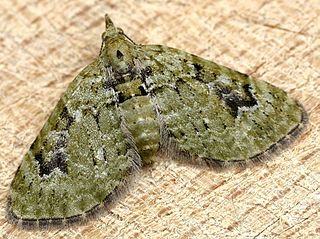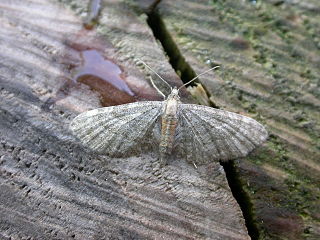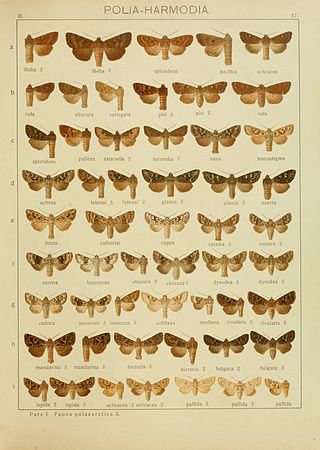
Clematis is a genus of about 380 species within the buttercup family, Ranunculaceae. Their garden hybrids and cultivars have been popular among gardeners, beginning with Clematis 'Jackmanii', a garden standby since 1862; more cultivars are being produced constantly. They are mainly of Chinese and Japanese origin.

The v-pug is a moth of the family Geometridae. It is found throughout the Palearctic region, the Near East and North Africa. It is well distributed in the British Isles except for the north of Scotland. The species was first described by Adrian Hardy Haworth in 1809.

The willow beauty is a moth of the family Geometridae. It is a common species of Europe and adjacent regions. While it is found widely throughout Scandinavian countries, which have a maritime climate, it is absent from parts of the former USSR which are at the same latitude but have a more continental climate.

Clematis virginiana is a vine of the Ranunculaceae native to North America from Newfoundland to southern Manitoba down to the Gulf of Mexico. The rationale for some of the common names is unclear, as they include examples normally applied to unrelated plants, including twining parasites. The name "Love Vine" also is applied to alleged aphrodisiacs, such as Caribbean species of Cassytha, which are unrelated to Clematis, not being in the family Ranunculaceae.

Clematis vitalba is a shrub of the family Ranunculaceae.

Clematis terniflora is a plant in the buttercup family, Ranunculaceae. It is native to northeastern Asia. It was introduced into the United States in the late 1800s as an ornamental garden plant, and has naturalized in many of the eastern states. It is considered a Category II invasive plant in Florida and some other eastern states, meaning invading native plant communities but not yet seen as displacing native species.

Horisme vitalbata, the small waved umber, is a moth of the family Geometridae. The species was first described by Michael Denis and Ignaz Schiffermüller in 1775. It occurs in Europe.

Melanthia procellata, the pretty chalk carpet, is a moth of the family Geometridae. It is found throughout Europe.

Horisme tersata, the fern, is a moth of the family Geometridae. The species was first described by Michael Denis and Ignaz Schiffermüller in 1775 and it can be found in the Palearctic realm.

Herminia grisealis, the small fan-foot, is a litter moth of the family Erebidae. It is found in Europe. The eastern expansion is across the Palearctic to the Ussuri River and after that Japan. In the Alps it rises up to a height of 1300 meters.

Eupithecia haworthiata, or Haworth's pug, is a moth of the family Geometridae. The species was first described by Henry Doubleday in 1856. It can be found in western, south and central Europe, Asia Minor, the Caucasus and east across the Palearctic to Amur. It occurs in the Alps up to 1800 meters, in the Apennines up to 1400 metres and in the Balkan mountains up to 1500 m above sea level.

Clematis aristata, known as Australian clematis, wild clematis, goat's beard or old man's beard, is a climbing shrub of the family Ranunculaceae, found in eastern Australia in dry and wet forests of Queensland, New South Wales, Victoria and Tasmania. In spring to early summer it produces mass displays of attractive star-shaped flowers usually borne in short panicles with each flower up to 70 mm diameter and possessing four narrow white or cream tepals. Fertile male and female reproductive structures occur in flowers of separate plants (dioecy) making this species an obligate outcrosser with pollen movement among plants most likely facilitated by insects. Each seed head on female plants consists of multiple achenes with each seed bearing a plumose awn 2–4.5 cm long promoting dispersal by wind.

Lasionycta calberlai is a moth of the family Noctuidae. It is found in France , Switzerland, Italy and Slovenia.

Phaiogramma etruscaria is a species of moth of the family Geometridae.

Gnophos furvata is a species of moth in the family Geometridae. It is found in southern and central Europe. In the east, the range extends to the Carpathian Mountains and Ukraine.

Asaphodes chlamydota is a moth in the family Geometridae. It is endemic to New Zealand, and can be found in the lower part of the North Island and in the South Island. It inhabits native forest and shrublands. The larvae of this species feeds on native Clematis plants including Clematis afoliata. Adults are on the wing from November to April and are regarded as having intermedia flight powers.

Pero meskaria, Meske's pero moth, is a species of moth in the family Geometridae. It was described by Alpheus Spring Packard in 1876 and is found in North America, where it has been recorded from southern Texas west to California, east through Nevada, Utah and western Colorado.

Clematis 'Princess Diana' is a hybrid cultivar of Clematis, which was introduced in 1984. The cultivar was produced by British clematis breeder Barry Fretwell and named in honour of Princess Diana of Wales. The cultivar was created by hybridizing Clematis texensis with the cultivar Clematis 'Bees Jubilee'. The Royal Horticultural Society awarded this cultivar with a prestigious Award of Garden Merit in 2002.
This page is based on this
Wikipedia article Text is available under the
CC BY-SA 4.0 license; additional terms may apply.
Images, videos and audio are available under their respective licenses.


















